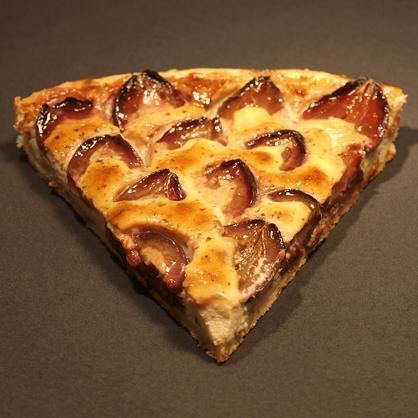 | ||
Similar | ||
Fruchtw he aprikosenw he aprikosenkuchen w he fladen kuchen
The term Wähe (which derives from the dialect in the regions of Basel, Zurich, Baden and Alsace) refers to a flat cake typical of the Swiss and Alemannic cuisine. A Wähe is prepared basically with short pastry - also known in German as "Kuchenteig" - and a topping of either fruits, vegetables or cheese. Wähen are sometimes prepared with yeast dough and occasionally with puff pastry. A Wähe is made with a mixture of milk (or cream) and eggs, and it rises to become thick and yellow when baked. The fruits or vegetables are baked together with the Wähe. The preparation is thus very similar to that of the French Quiche or Tarte.
Contents
- Fruchtw he aprikosenw he aprikosenkuchen w he fladen kuchen
- History
- Regional names
- Savoury When
- Sweet When
- Local specialities
- Similar dishes
- References

History

The Wähe is likely to have originated in central Switzerland. The first documented mention of the term "wäye" dates back to 1556 when it was described as a bun or cake in a lexicon from the Zurich area. The Wähe was first created in home baking and, according to Albert Spycher, it was made with the dough leftovers from bread-baking. The scraps of bread dough were rolled out into round flat cakes, the edges of which had to be raised and pressed together to prevent the topping from leaking out. They were topped with all those ingredients that were readily available at home. Since both fruits and vegetables were suitable ingredients, it is rather difficult to separate the story of the savoury Wähe from the sweet version.

However, the Wähe did not remain just poor man´s food, it also became very popular with the middle-class. The recipe for an "apple Dünne" can be found in "The Cook Book of Catharina Fehr" (1824), which was widespread among the burgeoisie. According to this recipe you need butter pastry, sliced apples, and a sauce made of flour, wine, sugar and raisins. Since the 19th century the Wähe has also been prepared in industrial bakeries.
Originally, the Wähe was a food eaten during fasting in the Catholic parts of Switzerland, particularly in the East. On the other hand, it was a festive dish in the Protestant areas, above all in the West. In some regions (Freiburg and Waadtland) the Wähe was usually eaten on Friday, when meat was not allowed. Even today, many bakeries offer the Wähe only on Friday because of this tradition. In the mountain regions, the Wähe has been known only since the early 20th century, probably because there ovens were very rare. In the alpine regions, given the prevailing livestock and milk production were prepared mainly Wähe with cheese and cream. The variety with fruit was the most common in the fruit-growing areas of the rural regions. Today both sweet and savoury Wähe are baked in every regions.
Regional names

The following words are used as partial synonyms for the 'Wähe'. This, however, does not mean that each specific variety is baked according to the same recipe, because many names have a broader meaning that can refer to other kinds of cakes too. For each region there is an individual recipe and dialect name for the Wähe.
In French speaking Switzerland the cake similar to a Wähe is called a «gâteau», in Italian speaking Switzerland a «torta» or «crostata», in Romansh a «tuorta».
Savoury Wähen
Savoury Wähen are coated with onions, cheese and/or bacon. The Cheese Wähe (also called a Cheesy Cake) is made with a cast of grated cheese (e.g. Gruyère cheese), cream and eggs.
Vegetable Wähen can be made with courgette, spinach, tomatoes or broccoli. Again a cast of grated cheese, cream or milk and eggs is used.
Sweet Wähen
Typically, sweet Wähen are covered with fruit, especially with plums, apple, rhuarb, cherries, huckleberries, etc. – depending on the time of year fresh or deep frozen ones. Before the fruit is administered the dough is often powdered with a layer of grounded nuts. A cast of milk, cream, eggs and sugar is added before the baking of the Wähe. In southern Switzerland Wähen are often baked without this cast (corresponds to a tart).
Vermicelles, grape or red current Wähen are not coated until or just before the Wähe is finished baking.
Another sweet kind of Wähe is the Nidle-Cake, made from a cast of cream (Nidle), eggs and sugar.
Local specialities
The Zibelemärit (Onion market) in Bern traditionally goes with a Zwiebelkuchen for dinner.
The Basle Fastenwähe is made with a salty yeast-dough sprinkeled with caraway and looks quite like a pretzel. Other than the name these Fastenwähen have nearly nothing in common with the usual Wähe.
